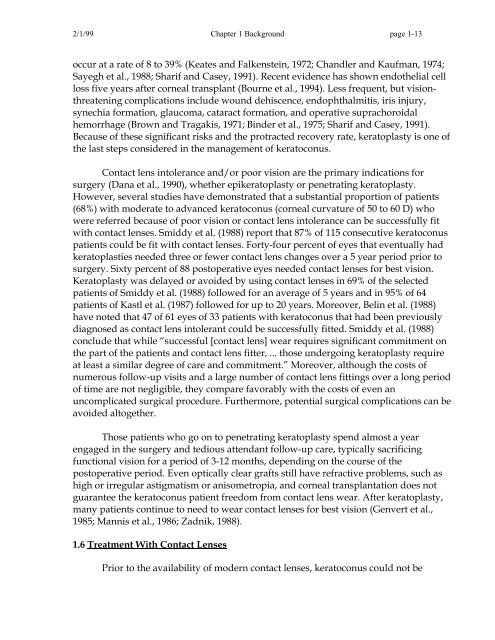OM t of c.iii - Vision Research Coordinating Center - Washington ...
OM t of c.iii - Vision Research Coordinating Center - Washington ...
OM t of c.iii - Vision Research Coordinating Center - Washington ...
You also want an ePaper? Increase the reach of your titles
YUMPU automatically turns print PDFs into web optimized ePapers that Google loves.
2/1/99 Chapter 1 Background page 1-13<br />
occur at a rate <strong>of</strong> 8 to 39% (Keates and Falkenstein, 1972; Chandler and Kaufman, 1974;<br />
Sayegh et al., 1988; Sharif and Casey, 1991). Recent evidence has shown endothelial cell<br />
loss five years after corneal transplant (Bourne et al., 1994). Less frequent, but visionthreatening<br />
complications include wound dehiscence, endophthalmitis, iris injury,<br />
synechia formation, glaucoma, cataract formation, and operative suprachoroidal<br />
hemorrhage (Brown and Tragakis, 1971; Binder et al., 1975; Sharif and Casey, 1991).<br />
Because <strong>of</strong> these significant risks and the protracted recovery rate, keratoplasty is one <strong>of</strong><br />
the last steps considered in the management <strong>of</strong> keratoconus.<br />
Contact lens intolerance and/or poor vision are the primary indications for<br />
surgery (Dana et al., 1990), whether epikeratoplasty or penetrating keratoplasty.<br />
However, several studies have demonstrated that a substantial proportion <strong>of</strong> patients<br />
(68%) with moderate to advanced keratoconus (corneal curvature <strong>of</strong> 50 to 60 D) who<br />
were referred because <strong>of</strong> poor vision or contact lens intolerance can be successfully fit<br />
with contact lenses. Smiddy et al. (1988) report that 87% <strong>of</strong> 115 consecutive keratoconus<br />
patients could be fit with contact lenses. Forty-four percent <strong>of</strong> eyes that eventually had<br />
keratoplasties needed three or fewer contact lens changes over a 5 year period prior to<br />
surgery. Sixty percent <strong>of</strong> 88 postoperative eyes needed contact lenses for best vision.<br />
Keratoplasty was delayed or avoided by using contact lenses in 69% <strong>of</strong> the selected<br />
patients <strong>of</strong> Smiddy et al. (1988) followed for an average <strong>of</strong> 5 years and in 95% <strong>of</strong> 64<br />
patients <strong>of</strong> Kastl et al. (1987) followed for up to 20 years. Moreover, Belin et al. (1988)<br />
have noted that 47 <strong>of</strong> 61 eyes <strong>of</strong> 33 patients with keratoconus that had been previously<br />
diagnosed as contact lens intolerant could be successfully fitted. Smiddy et al. (1988)<br />
conclude that while “successful [contact lens] wear requires significant commitment on<br />
the part <strong>of</strong> the patients and contact lens fitter, ... those undergoing keratoplasty require<br />
at least a similar degree <strong>of</strong> care and commitment.” Moreover, although the costs <strong>of</strong><br />
numerous follow-up visits and a large number <strong>of</strong> contact lens fittings over a long period<br />
<strong>of</strong> time are not negligible, they compare favorably with the costs <strong>of</strong> even an<br />
uncomplicated surgical procedure. Furthermore, potential surgical complications can be<br />
avoided altogether.<br />
Those patients who go on to penetrating keratoplasty spend almost a year<br />
engaged in the surgery and tedious attendant follow-up care, typically sacrificing<br />
functional vision for a period <strong>of</strong> 3-12 months, depending on the course <strong>of</strong> the<br />
postoperative period. Even optically clear grafts still have refractive problems, such as<br />
high or irregular astigmatism or anisometropia, and corneal transplantation does not<br />
guarantee the keratoconus patient freedom from contact lens wear. After keratoplasty,<br />
many patients continue to need to wear contact lenses for best vision (Genvert et al.,<br />
1985; Mannis et al., 1986; Zadnik, 1988).<br />
1.6 Treatment With Contact Lenses<br />
Prior to the availability <strong>of</strong> modern contact lenses, keratoconus could not be
















